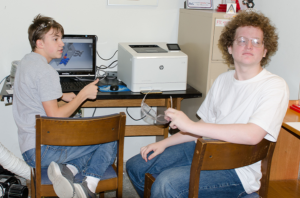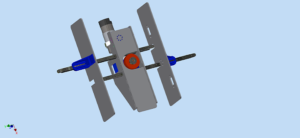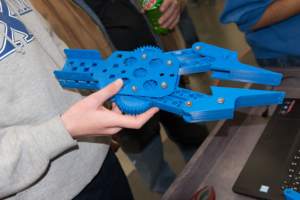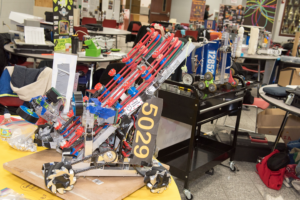FIRST Tech Challenge Robotics Competition Teaches STEM Students in Dayton About Teamwork, Robots, and 3D Printing
 Educational programs and activities for kids offer an invaluable way for the next generation to not only learn about next-generation technologies like 3D printing, but also about teamwork, public speaking, and even how to put together a decent presentation. We’ve covered the innovative non-profit For Inspiration and Recognition of Science and Technology (FIRST) program before; it encourages cool LEGO and robotics projects and challenges in education. There are four levels of the program, starting with FIRST Lego League Jr. for students in kindergarten through fourth grade, and continuing all the way through junior high and high school with FIRST Lego League, FIRST Tech Challenge, and FIRST Robotics Competition.
Educational programs and activities for kids offer an invaluable way for the next generation to not only learn about next-generation technologies like 3D printing, but also about teamwork, public speaking, and even how to put together a decent presentation. We’ve covered the innovative non-profit For Inspiration and Recognition of Science and Technology (FIRST) program before; it encourages cool LEGO and robotics projects and challenges in education. There are four levels of the program, starting with FIRST Lego League Jr. for students in kindergarten through fourth grade, and continuing all the way through junior high and high school with FIRST Lego League, FIRST Tech Challenge, and FIRST Robotics Competition.
Last summer, while attending the Dayton Mini Maker Faire, I had the pleasure of speaking with the FIRST Tech Challenge Robotics team from the Dayton Regional STEM School (DRSS), which is the school’s founding team for the FIRST program.“FIRST is more than robots,” the program’s founder Dean Kamen says on the website. “The robots are a vehicle for students to learn important life skills. Kids often come in not knowing what to expect – of the program nor of themselves. They leave, even after the first season, with a vision, with confidence, and with a sense that they can create their own future.”
Team #4537 – DRSS Enterprise, which was sponsored last year by Dayton’s own Proto BuildBar, had used some 3D printed and laser cut parts for its competition robot, and I learned that the students also use 3D printing to make keychains to sell for fundraising efforts. The team members come from schools all over the Dayton area, and enjoy the chance to learn about professionalism, public speaking, CAD programs, and 3D printing while they spend three months designing robots from the ground up that will play a floor game in an alliance format at competition.
The team’s coach, Kerry Hicks, reached out to me this winter to let me know that the students would be competing against 11 other teams in a nearby FIRST Tech Challenge robotics competition, with a robot featuring many 3D printed parts.
“I know our robot has a few mechanisms that would have taken much, much longer to design if it wasn’t for 3D printing (and laser cutting),” Hicks told me.
I was unfortunately not able to attend the competition, where Team #4537 – DRSS Enterprise did very well: they scored third place overall and advanced to the state championship, which took place this spring. They also won the Connect Award, given to teams that can “connect the dots” between the FIRST program, their community, and the diversity of the engineering field.
The award description reads, “The recipient of this award is recognized for helping the community understand FIRST, the FIRST Tech Challenge, and the Team itself. The Team that wins the Connect Award aggressively seeks and recruits engineers and explores the opportunities available in the world of engineering, science and technology.”
 Hicks was kind enough to take photos at the event, answer some questions for me, and have the high school team members answer a few questions as well. She explained that the coaches and parents all hope that FIRST can help students improve upon their skills “in many areas such as engineering and software.” One team member said that they hoped to gain valuable experience in time management and teamwork, while a second hoped for a chance to “get more in touch with the community with the future of innovation.”
Hicks was kind enough to take photos at the event, answer some questions for me, and have the high school team members answer a few questions as well. She explained that the coaches and parents all hope that FIRST can help students improve upon their skills “in many areas such as engineering and software.” One team member said that they hoped to gain valuable experience in time management and teamwork, while a second hoped for a chance to “get more in touch with the community with the future of innovation.”
A third student explained, “I hope that I would be able to further improve my programming skills to be able to get a job with programming in the future. I would also like to make it so that would be able to have the ability to think of solutions to problems that might happen with the robot and or program.”
They can also learn presentation, problem solving, outreach, engineering, programming, CAD, and writing skills, and how to work together.
One team member touched on just how important programs like FIRST are for teaching skills that you may not necessarily learn in books:
“One of the more significant skills I developed was cooperating with others to complete a larger task. Before joining the team, I had always been drawn to work alone, as I found it somewhat difficult to effectively link my thoughts with those of people I was working with. After a year and a half in the program, I find that I am far more capable of being a functional part of a larger team.”
The team regularly uses a $300 Monoprice 3D printer, owned by their lead coach, to create robot assembly parts.
“Our coach played around with its settings and such items, and got it to produce precise enough prints that we can use them effectively on the robot,” one of the team members told me.
They also use a team-owned laser cutter from Rabbit Laser – one of the team’s sponsors – to cut flat objects out of multiple materials, such as acrylic, high-impact polystyrene, and wood, and utilize CAD to make sure everything fits before 3D printing and laser cutting the parts.
The same team member explained, “Due to the nature of the device, this is far faster at making items than the printer, offering efficient solutions to certain problems. This is often used in sync with the 3D printer to create a design that satisfies all of its constraints and roles, and performs well.
“We use 3D printing when we need a flexible solution to a problem that could not be solved effectively any other way. While exceedingly versatile, 3D printing the component required is often not the most efficient solution, as it takes considerable time to print a component, they tend to be more fragile than other items, and the plastic filament is relatively expensive. In other words, while we could (in theory) 3D print the entire robot, there are a lot more efficient methods to build a robot.”
FIRST Tech Challenge teams get about two to four months to design and build their robots, though they make improvements and modifications throughout the entire season. Time also depends on when competitions are held.
“Our team typically signs up for our first competition in early December, as this is usually enough time to get a basic robot running, and we then can see what strategies other teams are using,” a team member explained. “As the robot game typically has a repeatable scoring element, and a large concentration of points in another mission, we often design to be effective at the repeatable task for the first competition. The high value mission is then focused on after the first scoring mechanism is working well, allowing us to be more competitive against teams that have been preparing for longer.
- Blue and red parts are 3D printed; white parts are laser cut.
Team #4537 from DRSS definitely believes that it would have taken them longer to build the robot without using custom-designed parts that were laser cut or 3D printed. In addition, the 3D printed parts cost less and helped the robot maintain a higher level of performance.
Inside view of the gripping mechanism – blue custom mount holds motor in a specific spot. The team designed the red gear to work a double linear drive (linear gears are on the metal bars).
One team member told me, “Due to the relatively considerable need for custom-made parts for the design of this year’s robot, a great many of the parts would have had to have been handcrafted, or, in the case of mechanical parts or anything that required precision, commercially purchased. Since the printer can be run outside of practice, and the laser cutter can burn away parts on its own, we would need to use practice time to create parts. As such, it would take much more time and effort to design a robot without the aid of accessible precision manufacturing.”
The team is allowed some adult help from its coaches and mentors in terms of registration, finding opportunities for outreach, and providing advice and some direction if needed, but in terms of building the robot, “the primary responsibility lies with the students on the team.”
“Coaches also will provide an extra set of hands where needed, but other than this, the vast majority of the work is done by the team members,” one team member told me, though he did mention that their coach, who owns the 3D printer, will often have it complete print jobs outside of practice.

Looking down into the “grab and lift” mechanism, which features 3D printed motor mounts (blue), rack
and pinion parts (red), and gears (not visible).
I asked the team members what they thought some of the benefits were of having STEM events, like the FIRST Tech Challenge, for students. In addition to future engineering job skills, like CAD, 3D printing, and Android Java, they also listed exposure to new people and opportunities and learning how to “develop ideas and answers for questions in a more innovative and creative way” as advantages.
“Since I started doing activities like this, I have noticed a significant change in the way I approach challenges – I tend to view a complex problem as a series of steps, and work off of those steps,” one of the team members told me. “These activities also give use insight into the modern world, and the broad range of ideas that are available to us. Experience in these activities is useful in many professions, whether the experience is in working as a part of a larger group or operating within a CAD program.”
Learning first-hand skills in business, engineering, leadership, and programming is invaluable to young students, as this will help them become better candidates for employment when they enter the job market in the future.
The FIRST website says in regards to the event experience, “FIRST Tech Challenge events are amazing, inspiring experiences. Where else can you make new friends, share ideas, solve problems on the fly, compete like crazy, and get pumped up over technology all while having the time of your life? At FIRST Tech Challenge events, students realize more than ever that FIRST is all about teamwork, sharing, helping others, and respect.”
Registration for the nationwide program just opened up this month. If you’re a kid learning to learn about technology and teamwork, find a team to join! Adults can participate as well, by volunteering to sponsor, coach, or mentor student teams, and you can make donations as well.
Check out the video below to see some of these robots in action:
You can also take a look at the pictures Kerry Hicks, with Team #4537 – DRSS Enterprise, shared with me of robots from some of the other teams this winter:
- Robot X (Team 4969) 3D printed a giant claw from a Thingiverse design.
- Robot X also 3D printed an electronic cane/mobility aid for a community service project.
- A team member from Broken Axles (Team 6298) designed his first CAD project – a phone mount for the team’s robot.
- An early design from the PowerStackers (Team 5029) used 3D-printed rollers to make a long conveyor system to move and stack foam blocks.
- 4537 (DRSS Enterprise) arm using a gripping hand & thumb based on a part of a design posted on Thingiverse by FTC 11722 and FTC10544.
Discuss this and other 3D printing topics at 3DPrintBoard.com or share your thoughts in the comments below.
[Photos provided by Kerry Hicks]Subscribe to Our Email Newsletter
Stay up-to-date on all the latest news from the 3D printing industry and receive information and offers from third party vendors.
Print Services
Upload your 3D Models and get them printed quickly and efficiently.
You May Also Like
Reinventing Reindustrialization: Why NAVWAR Project Manager Spencer Koroly Invented a Made-in-America 3D Printer
It has become virtually impossible to regularly follow additive manufacturing (AM) industry news and not stumble across the term “defense industrial base” (DIB), a concept encompassing all the many diverse...
Inside The Barnes Global Advisors’ Vision for a Stronger AM Ecosystem
As additive manufacturing (AM) continues to revolutionize the industrial landscape, Pittsburgh-based consultancy The Barnes Global Advisors (TBGA) is helping shape what that future looks like. As the largest independent AM...
Ruggedized: How USMC Innovation Officer Matt Pine Navigates 3D Printing in the Military
Disclaimer: Matt Pine’s views are not the views of the Department of Defense nor the U.S. Marine Corps Throughout this decade thus far, the military’s adoption of additive manufacturing (AM)...
U.S. Congress Calls Out 3D Printing in Proposal for Commercial Reserve Manufacturing Network
Last week, the U.S. House of Representatives’ Appropriations Committee moved the FY 2026 defense bill forward to the House floor. Included in the legislation is a $131 million proposal for...














































